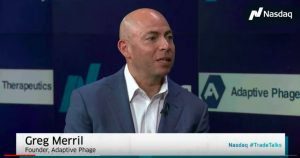
The BioHealth Capital Region is Growing But Still Faces Challenges Ahead
GEN, Genetic Engineering & Biotechnology News, released its annual ranking of the Top Ten US Biopharma Clusters, and the Biohealth Capital Region (BHCR) retained its spot at number four (4) for 2019.
In this year’s GEN Top 10 report, Alexandria Real Estate Equities executive chairman and founder Joel Marcus was quoted about what factors will most likely drive the future creation of clusters for biopharma and other emerging life sciences.
“Clusters take about a generation, 25 years, to really evolve and develop,” stated Marcus, emphasizing the importance of thinking long-term for building a strong cluster.
One of the most important factors for the long-term strategy is workforce, which also happens to be one of GEN’s five criteria used to measure cluster rankings. The other’s include NIH funding, venture capital (VC) and lab space.
The BHCR has continued to show substantial growth and garner global attention with new venture capital deals totaling $1.229 billion according to JLL. There were several exciting early stage venture-backed deals, including Thrive Early Detection out of Johns Hopkins University (JHU), which raised a $100M series A in 2019. Additional big dollar late stage venture deals contributed to that number and also led to IPOs this year. The top of the list includes Viela Bio who recently announced a $150M intended IPO, and NextCure who went public earlier in 2019 raising $86.5M in gross proceeds.
Talent and capital are routinely voiced by biohealth executives as the two biggest concerns faced by the BHCR companies. The recent VC investment growth cited above shows that the region is making progress towards answering the concern for more capital, however, little seems to be happening to solve the concerns about talent.
“We talk with dozens of companies each week and they are all becoming increasingly more concerned over their ability to hire and retain their workforce,” shared Chris Frew, CEO of recruiting and employer brand consulting firm, Workforce Genetics, LLC. “Many company executives are recognizing that we are entering a new era for the biotech industry, especially here in the BHCR, that is far from ‘business as usual’, and they are looking for new strategies that meet these growing workforce challenges head-on.”
The Talent Crisis
All of this success is great for a cluster, but it puts tremendous pressure on the region’s workforce demands as companies begin to scale. The BHCR’s talent market may not yet be in full crisis mode like it is in Boston where extreme competition for talent has resulted in skyrocketing wages, extravagant benefits, enormous signing bonuses and greater equity grants for new employees. But the BHCR might be heading that direction.
The pressure is compounded without a clear, long term workforce strategy and the infrastructure in place to support it.
The BHCR has a life science workforce of 55,882 jobs (according to JLL), sixth largest on the list, and is expanding rapidly. A rough DLLR projection shows that the life sciences industry will add an additional 7,137 jobs by 2026, reflecting a 13.2% increase. There are more than 2,000+ new industry jobs needed to be filled immediately according to job postings and various economic models.
So where are these jobs coming from? In short, everywhere and at companies of all sizes.
Much of the growth that is happening in Maryland is in advanced cell and gene therapy and immunotherapy, and we are rapidly becoming a global center for advanced biomanufacturing, according to Martin Rosendale, CEO of the Maryland Tech Council, who shared this view in a recent interview. Rosendale cited the expansion of Catalent, RoosterBio and Precigen as examples of growth in this sector.
There are hundreds of small biotechs and life science companies that are growing in the BHCR. PathoVax, for instance, which operates out of the FastForward incubator, is recruiting to add a few strategic hires and grow from a company of eight to a company of ten or fifteen employees. There are also dozens of mid-sized companies like RoosterBio, NexImmune and Neuraly who are seeing clinical or commercial success and are expanding from companies of 20-30 people to companies of more than 40-50. This represents significant growth at that size.
The challenge these small companies face is that they have limited resources and very specific hiring needs, which makes it not only hard to find those employees, but also hard to attract and hire the right talent because they are competing with the much larger, well-funded competitors.
At the other end of the spectrum, there are the established, rapid-growth companies that are hiring or are expected to hire 50-100+ new employees a year. GSK, REGENXBIO, MSD, Emergent BioSolutions, Kite Pharma and Catalent’s Paragon are all competing to recruit candidates to meet their growing demands. Paragon, for instance, is not only hiring hundreds this year organically, but they are growing so fast that they strategically acquired a portion of Novavax earlier this year to pick up 100+ of their employees immediately.
These larger companies all have a robust talent acquisition system in place but they are still finding it a major challenge to meet their growth demands. For them, it’s also about reaching the right candidates at the right time when they are ready to make a job change, and having a compelling enough employer value proposition to sway them to make the move.
“We are dealing with a perfect storm of sorts here in the region and nationally. Companies that are winning the talent wars are disrupting the traditional recruiting model to hire and keep the best people in a fiercely competitive battle for talent,” stated Ashley Nash, Director of Recruiting and Talent at Workforce Genetics.
Growing the Talent Pool
One of the biggest challenges in a rapidly growing cluster is that approximately 80% of talent exchange is local. Therefore, when almost all local companies are expanding, recruiting new talent from other local competitors isn’t shrinking the overall number of regional job openings.
The math is simple: When one company gains and employee, another is losing one. In total, the analysis of the DLLR data projects 5,122 job openings per year that will need filling.
As Shiva Fritsch, SVP Human Resources at REGENEXBIO, stated in a recent industry panel on this topic, “We can’t get there by just recruiting each other’s employees all the time. We need to do more to collectively attract more talent to the region.”
According to Rich Bendis in a recent article on the key elements to growing a globally competitive biohealth cluster, marketing and branding is so important for a region so people outside the region recognize that a cluster is a great place to work, to start or have a business, and is a good place to seek investments. Bendis feels strongly that BHCR brand promotion needs to happen more frequently and in a more coordinated fashion.
The biggest challenges exist for companies recruiting commercial operations, sales and marketing talent as they begin to emerge from the clinic and commercialize, as many more are beginning to do. Proportionately, there are fewer commercial biotechs here than in many other hubs, like Philly, NY, Boston, and San Francisco so this talent often has to be attracted from outside the region, which is more challenging and costly for companies to do.
Due to the rapidly growing biomanufacturing industry, many companies are now facing the need to relocate experienced biomanufacturing talent from other markets as well.
So what more can be done to make the BHCR attractive for talent and for it to get more recognition from outside of the region?
Developing the BHCR “brand” was an effort set into motion under the leadership of MedImmune, now AstraZeneca, four years ago that appears to be making progress. The BHCR brand is now recognized by GEN, referenced in several articles and appears on the websites of dozens of BHCR companies; however, it still hasn’t truly taken hold as a regional identifier, even for many locals.
There has been some great content and PR put out over the past year from several of the economic development groups that have proven really useful for companies. The Maryland Department of Commerce’s social media campaigns really focus on why Maryland is a great place to work and live if you’re in biotech, Montgomery County Economic Development Corporation (MCEDC) launched their “Built for Bio” video series which tells a good story, and Frederick Economic Development’s “Leading the Way” campaign really does a great job of selling the local story as well.
More can still be done to unify the message, market and promote this region and it’s the local companies who should be more active in doing so. Getting more companies and industry leaders involved in the messaging will be a key factor in this. Jeff Galvin, CEO of American Gene Technologies, for example, is very vocal about why his company is located in Maryland and why he believes that there is no better place to grow a biotech, especially in cell and gene therapy.
Developing and Training A Workforce for Tomorrow
With all of this regional growth and prosperity happening, one might expect to see several big workforce development programs and collaborations being announced as well.
For example, In Philadelphia (now ranked #6 by GEN) Thomas Jefferson University has invested $7M in opening the Jefferson Institute for Bioprocessing with a goal of training 2,500 bioprocessing professionals annually to meet the demands of the growing cell and gene therapy industry.
In the BHCR, very few similar initiatives seem to be taking shape. Nothing on the scale of the Jefferson Institute is on the horizon to meet the workforce demands that already exist today and that will only increase in years to come. There was a 2016 announcement of a cGMP Center of Excellence at the University of Maryland with support from the State and NIIMBL, but little press has been shared about the progress of that initiative, or if it is even still moving forward.
There are several established programs that have been the foundation of the region’s training solution. The University of Maryland’s Biotech Research and Training Program (BREP) is highly regarded for producing some of the top trained bioprocessing talent in the region, but it’s throughput is not nearly at the scale required to meet demand. Likewise, Montgomery College’s Biotech Program is recognized by many as one of the best lab tech and entry level manufacturing training programs in the region, but it also is not at scale.
With the lack of a major regional workforce infrastructure, several companies have begun to take it into their own hands and are aligning with local universities and colleges to influence curriculum and develop tailored workforce education and training programs that meet the needs that they know they will have in coming years.
Kite Pharma, for instance, is said to be developing The Kite-Hood Innovation Institute through a collaboration with Hood College in Frederick. Few companies have the budget or the necessary foresight to develop such programs, but those that do have sights on a biomanufacturing commercial workforce, seem to be exploring these new options.
Elevating the Conversation
There is no magic bullet to solve these workforce challenges because they take substantial planning and collaboration and, above all, time to fix. However, there is much we can do to educate and raise the level of conversation around this topic to help those who need it today and to start planning for the long-term.
Several organizations are seeking to raise the volume around this issue and use collaboration and awareness as a catalyst to generating much needed solutions.
Recently, Workforce Genetics and Scheer Partners partnered on an event aimed at bringing together HR and Hiring Managers to share success stories and advice with one another. The first event is a panel titled, “How Top Companies Attract, Engage and Retain Their BioHealth Workforce” that will be held at 704QO.
The panel, moderated by Whitney Harmel, Director of Strategic Partnerships, Maryland Chamber of Commerce, includes business and HR leaders who have experience solving these problems and growing their companies.

“The competition to attract, hire and retain talent has never been tougher. That’s why it is more important than ever to bring together those on the front line of the talent war to forge new relationships, collaborate and share the insights and practical tips they have learned to grow the workforce,” stated Frew. “Only by coming together can we meet the demand for talent head-on and work to establish the right long-term strategy that keeps the BHCR competitive as the best place to work and grow your career in biotech.”
To date, there are few industry-oriented programs or organized initiatives that are seeking to build momentum around this issue that are not government subsidized workforce programs or academic-led programs.
Workforce Genetics is seeking to spark a new kind of conversation around talent development. One that is organized and led by industry, that can immediately impact industry and influence a long-term strategy. Workforce Genetics has committed to making this a quarterly, industry-focused talent series with the support of others who are ready to elevate the conversation around talent in the BHCR.
There is no single solution that will solve these challenges, but a more intentional effort and investment from industry are what will have the greatest impact on them.
- About the Author
- Latest Posts
Steve brings nearly twenty years of experience in marketing and content creation to the WorkForce Genetics team. He loves writing engaging content and working with partners, companies, and individuals to share their unique stories and showcase their work. Steve holds a BA in English from Providence College and an MA in American Literature from Montclair State University. He lives in Frederick, Maryland with his wife, two sons, and the family dog.





